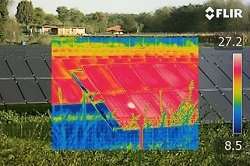A solution to fracture for durable solar cells

Micro cracks in solar cells are a frequent challenge for manufacturers of solar photovoltaic modules. EU-funded researchers introduced an innovative pre-stressing technique to retard the growth of cracks and make durable solar cells.
Regular silicon solar cells are made of very thin wafers, usually around 200 microns thick. Although they have some ability to flex, they can suffer from cracks – often induced by mechanical forces or thermal stresses. These micro cracks are so small that they are impossible to see with the naked eye, making detection difficult. "In particular micro cracks can be caused by poor handling of the solar cells during their production, by transport or installation damage of the modules or by exposure to various climatic impact factors," notes Prof. Marco Paggi who has been in charge of the EU-funded project PHYSIC.
Building on the pioneering research conducted by another project granted by the European Research Council, researchers working on PHYSIC concluded that all causes of cracking in silicon solar cells are primarily related to the brittleness of the material. Therefore, the industrial trend to reduce the thickness of solar cells to save material can enhance the effect of cracking and be detrimental to the durability of the photovoltaics module.
A small stress boosts conductivity
To find a possible remedy for crack growth, researchers took a mechanics perspective on the problem. At the core of their approach was that solar cells are not standalone components, but are rather embedded into a laminate structure composed of various layers of different materials including glass and polymers.
The team placed focus on the residual stresses present during the lamination process that are caused by the different thermoelastic properties of various materials. "Careful analysis led to the discovery that exerting a weak residual compressive stress on solar cells after module manufacturing can increase electric conductivity around any crack. Due to these desirable residual stresses, cracks tend to close, letting electric current pass freely through them," explains Prof. Paggi.
By applying an innovative pre-stressing technique on the backsheet material – the last polymeric layer forming the laminate structure that is found opposite to the glass – researchers managed to increase the amount of compressive stresses in silicon and achieve a crack closure for the majority of cracks. Electroluminescence data of cracked solar cells before and after treatment provided clear evidence that the solar cell dark portions become electrically conductive again after the newly proposed pre-stressing technique.
Resistance to cracks matters
PHYSIC unveiled a new generation of photovoltaic modules that displays superior resistance against cracking. The project approach hinged on fundamental mechanics principles of composites that have been left unaddressed so far by photovoltaic manufacturers. "Neglecting material degradation issues can prove very harmful for the operation of photovoltaic modules, leading to electric power losses much higher than what is saved by focusing on increasing the solar energy conversion efficiency," adds Prof. Paggi.
Provided by CORDIS




















